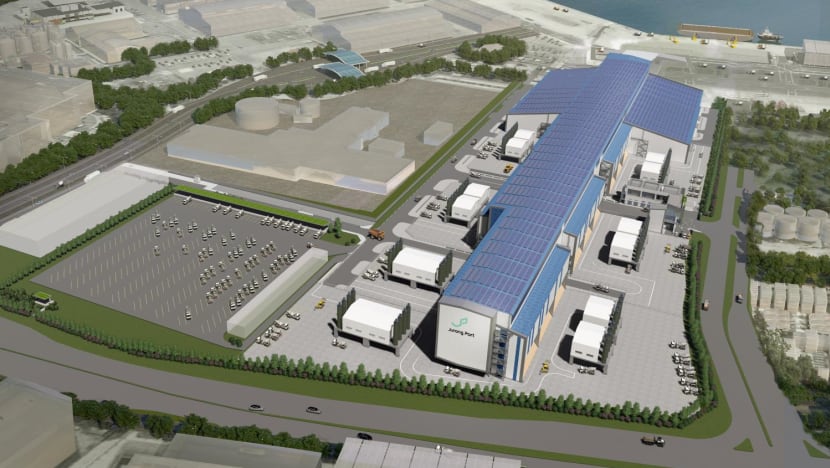Singapore’s first integrated construction park, located at Jurong Port, will be operational from December 2022.
It will bring together key supply chain players in the construction industry, making it easier for them to collaborate, as well as share resources and facilities. These include storage yards and ready-mix concrete batching plants.
The integrated construction park is one of several initiatives that form part of a new Industry Transformation Map (ITM), announced by Minister for National Development Desmond Lee on Tuesday (Sep 6).
Speaking at the opening of the International Built Environment Week, Mr Lee said that bringing the construction facilities together will lead to greater efficiencies when producing construction components. For example, raw materials like cement, sand and granite can be transported using conveyor systems instead of lorries.
This can also result in a more efficient and greener construction materials supply chain, said the Building and Construction Authority (BCA).
Mr Lee said that the concept will be trialled at Jurong Port before authorities consider replicating it in other locations.
Construction activity has returned to close to pre-COVID levels and the manpower situation has stabilised, Mr Lee said, noting that the BCA is on track to achieve its projected demand of S$27 billion to S$32 billion this year.
But the lessons from the pandemic have also prompted a review of how the industry can be transformed, Mr Lee said as he launched a refreshed Built Environment ITM.
“We are not starting from scratch. This refreshed BE ITM builds on the progress that we have made under the Construction ITM and our Facilities Management transformation plans,” he said.
“But we will now do much more to integrate all of these efforts, and adopt a building lifecycle approach towards transformation.”
INTEGRATED DESIGN AND PLANNING
Before integrating construction facilities, the industry will be nudged to adopt integrated design and planning, as well as collaborative contracting practices.
The BCA will encourage greater adoption of Integrated Digital Delivery which allows for collaboration by stakeholders through digital platforms.
It will also push for a redesign of conventional contracts to motivate parties to work together, build trust and facilitate risk-sharing.
Seven agencies have identified nine upcoming public sector projects to pilot collaborative contracting, Mr Lee said.
The BCA is also targetting to increase the adoption of prefabricated buildings or Design for Manufacturing and Assembly (DfMA) from 44 per cent currently to 70 per cent by 2025.
This means more off-site production will be done in a factory environment with greater adoption of automation, said BCA.
“We must do so. We aim to be less reliant on low-skilled foreign manpower, and really upskill, and up the value chain in construction technology,” said Mr Lee.
“Our latest move is to require all large building projects to adopt DfMA technologies from April 2022.”
The ICPs will support this by allowing for more automation and robotics in the production of precast and PPVC (prefabricated prefinished volumetric construction) modules.
Mr Liam Wee Sin, co-chair for the Urban Systems Cluster of the Future Economy Council, told reporters that COVID-19 showed how the industry is vulnerable as it is highly dependent on migrant workers and low in productivity.
“With the lessons learned from COVID, we’ve moved a step further … to address all the vulnerability of our industry, and how we can then move forward to rise to the challenges of being more resilient, to be more productive, and also to bring a new way in which we work collaboratively,” said Mr Liam, who is the group chief executive of UOL.
SMART FACILITIES MANAGEMENT
Another key aspect of the ITM is for greater adoption of smart facilities management, which aims to integrate different aspects of building management by using technology.
Mr Lee said that 80 per cent of public buildings should adopt Smart FM by 2030. The BCA is setting a new target for 40 per cent of private buildings by gross floor area to adopt Smart FM by the same year.
He gave the example of Jewel at Changi Airport, which has complex operations as it is attached to one of the busiest airports in the world and has an indoor forest and waterfall.
But Jewel’s maintenance team is kept lean and efficient through the integration of security, building maintenance and guest services through Certis’ integrated platform,” said Mr Lee, adding that employees can monitor the status of all building facilities through the integrated platform.
He encouraged firms to apply for a grant, announced at the Ministry of National Development’s Committee of Supply this year, to develop such capabilities.
Mr Lee said that the refreshed ITM aims to build a sector that is more productive and resilient, contributes to a more sustainable environment and possesses “deep capabilities”.
Four projects that demonstrated high standards in sustainability, productivity and digitalisation were given the new Built Environment Transformation Award at the opening event.
The winners are Tampines condominium development The Tapestry, office building PSA Liveable City, Eunoia Junior College and JTC’s 1 and 7 North Coast developments in Woodlands North Coast.
Source: Hellenic Shipping News






